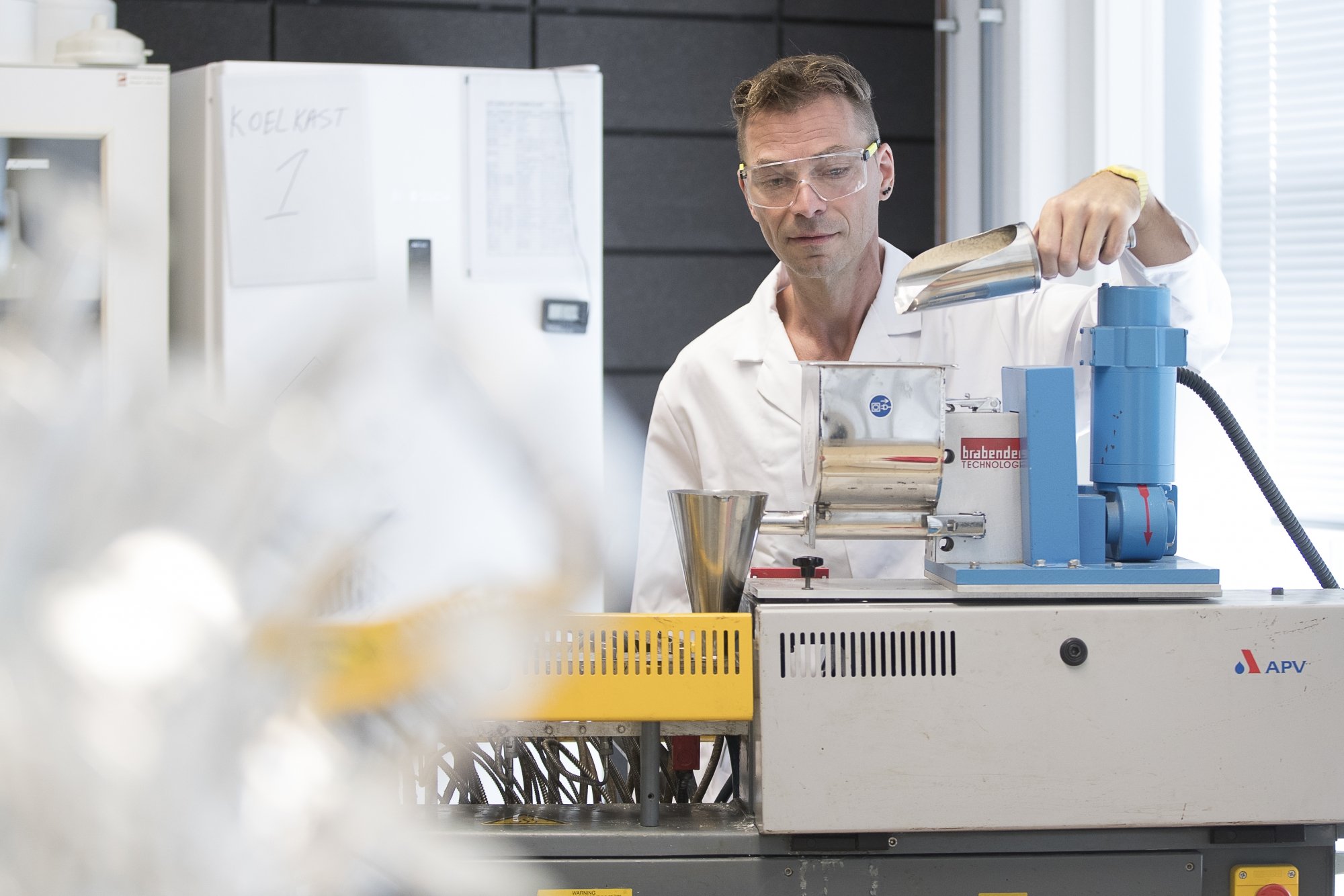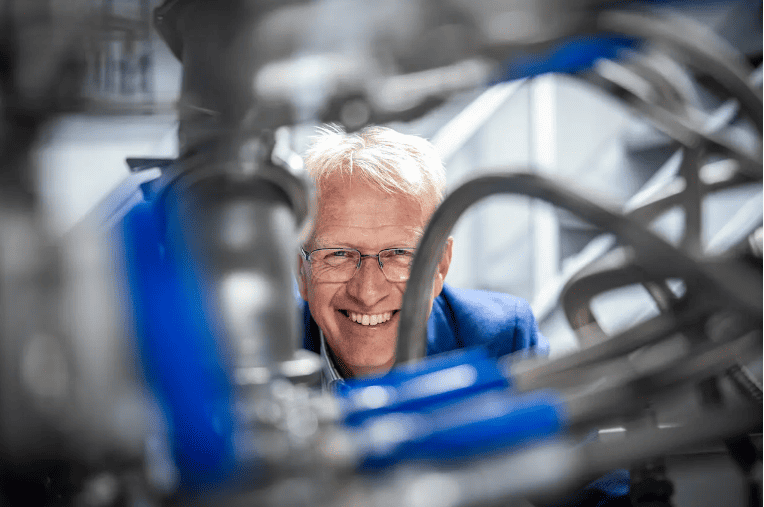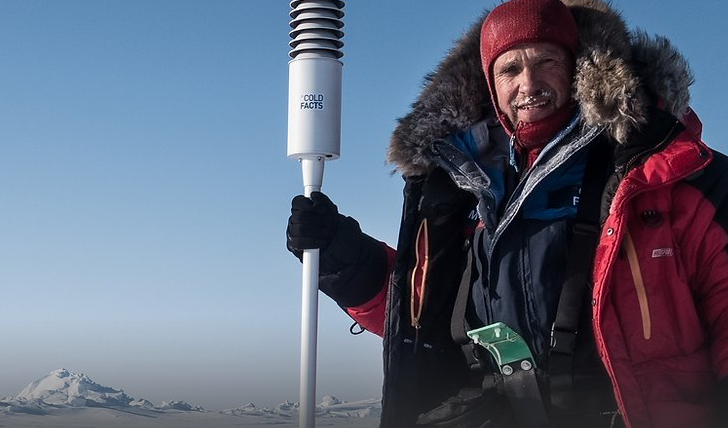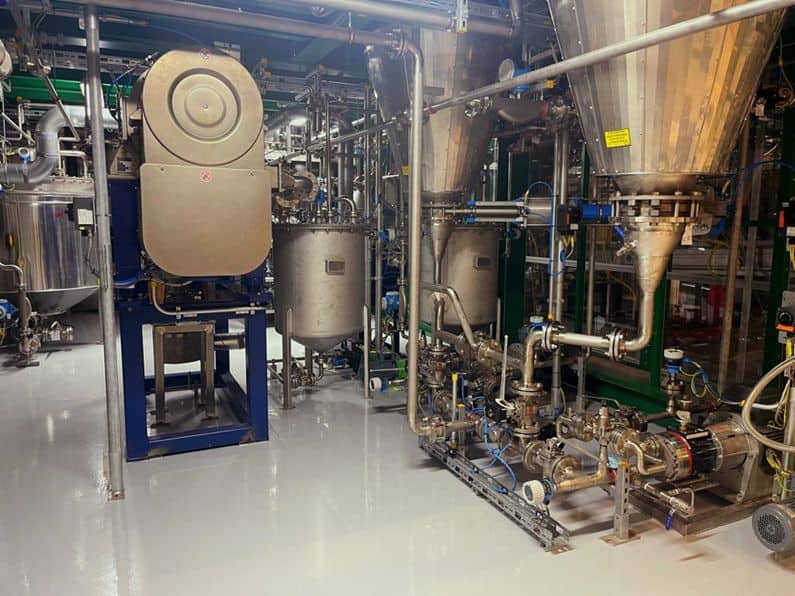
[et_pb_section bb_built=”1″][et_pb_row][et_pb_column type=”4_4″][et_pb_text _builder_version=”3.12.2″]
When it comes to durability, chemical industry and durability don’t go hand in hand. The first things that come to mind when talking about chemical industry are often smoking chimneys or hazardous substances. That can’t be durable, can it?
[/et_pb_text][et_pb_text _builder_version=”3.12.2″]
 But that is exactly what the team at Brightlands Materials Center, an initiative of TNO and the Provence of Limburg, is concerned with. In an old building at Brightlands Chemelot Campus in Geleen, the R&D team is looking for ways to change applications of plastic. The goal: making the plastics industry more sustainable. Along with Peter Wolfs, Marnix van Gurp is the manager of this development center. As he walks through the outdated hallways, he shows all that is happening to ‘reinvent’ plastic. He and his team will soon move to a new building on the campus.
But that is exactly what the team at Brightlands Materials Center, an initiative of TNO and the Provence of Limburg, is concerned with. In an old building at Brightlands Chemelot Campus in Geleen, the R&D team is looking for ways to change applications of plastic. The goal: making the plastics industry more sustainable. Along with Peter Wolfs, Marnix van Gurp is the manager of this development center. As he walks through the outdated hallways, he shows all that is happening to ‘reinvent’ plastic. He and his team will soon move to a new building on the campus.
[/et_pb_text][et_pb_testimonial _builder_version=”3.12.2″ author=”Marnix van Gurp” job_title=”Managing director” company_name=”Brightlands Materials Center” quote_icon_background_color=”#f5f5f5″ text_orientation=”center” animation_style=”flip” animation_direction=”top” saved_tabs=”all”]
“We are really going to be in trouble when it comes to the recyclability of all those different materials.
[/et_pb_testimonial][et_pb_text _builder_version=”3.12.2″]
It’s everywhere
That ‘reinvention’ is highly necessary, he finds, because the way it is going now can’t go on any longer. Van Gurp: “The range of different plastics is incredibly wide. There are dozens of sorts with additives for colour, strength and other user requirements. Plastic for inside, for outside. It shouldn’t catch fire or it has to be flexible, for each application, there’s a type of plastic. It’s everywhere; in bottles, toys, packaging and clothes. In this, we as a society have completely gone mad”, this visibly annoys Van Gurp. Gesticulating, he continues: “For years now, we have been looking for a solution for the increasing problem with plastics, so far with limited success. We are really going to be in trouble when it comes to the recyclability of all those different materials.”
[/et_pb_text][/et_pb_column][/et_pb_row][et_pb_row][et_pb_column type=”1_2″][et_pb_text _builder_version=”3.12.2″]
The process can always be more sustainable
Not only the recycling of materials has priority according to van Gurp: “A lot of the plastic waste now ends up in the sea or it goes to an incinerator, which emits a lot of CO2. We are looking for circular solutions in which materials should leave the lowest possible footprint on the environment.”
At the Brightlands Materials Center, they are trying to reduce that footprint by working on lighter materials for the car industry. Van Gurp: “Electrical driving will be the norm in a couple of years. The heavyweight of cars makes them less economical. By making the materials that are processed in cars lighter, you automatically reduce the impact on the environment. The material should obviously be just as strong, if not stronger. But in that, we’re also looking at the process. Durability is also about producing locally and reducing waste. Or processing waste flows into new products.”
[/et_pb_text][/et_pb_column][et_pb_column type=”1_2″][et_pb_text _builder_version=”3.12.2″ border_color_all=”#b7b7b7″ animation_style=”fold” background_color=”#f5f5f5″ custom_padding_last_edited=”on|” saved_tabs=”all” custom_css_main_element=”padding:3%;”]
Lightweight Automotive
Brightlands Materials Center focuses on materials and solutions for three different themes and industries. Additive manufacturing, Lightweight Automotive and Sustainable Buildings. For this, they are working on several projects along with universities, knowledge institutions and companies. In the Lightweight Automotive program, it’s all about developing light materials that make sure that vehicles drive more economically. But also about better production methods in which less waste is produced and about materials that are designed in such a way that they are easier to reuse. In 2019, there will be a showcase in the new building where new techniques and materials can be seen.
[/et_pb_text][/et_pb_column][/et_pb_row][et_pb_row][et_pb_column type=”4_4″][et_pb_image _builder_version=”3.12.2″ src=”https://media.innovationorigins.com/2018/12/photostique-brightlands-morres-076-2.jpg” /][et_pb_text _builder_version=”3.12.2″]
The car industry still uses a lot of materials which are difficult to recycle. In the testing ground Thermoplastics Composites, Brightlands Materials Center is working on materials that are more suitable for re-use, along with companies from the south of the Netherlands. The project is financed by Op-Zuid, the province of Limburg and the participating companies. Van Gurp: “A lot of composites are difficult to recycle, not only in the car industry. That also counts for fibreglass boats, hardened with synthetic resin, and the blades of windmills. Unlike composites, thermoplastics melt upon heating, which makes it easier to reuse them. The goal of the project is to replace metal in the car industry, but also to develop high-quality materials from residual materials.”
Text continues after the video.
[/et_pb_text][et_pb_text _builder_version=”3.12.2″]
Making carbon talk
Van Gurp puts on his safety goggles and walks into a testing room: “This is where we are figuring out how to use carbon – a composite made of carbon fibers and plastic – in a 3D printer. What is needed to make this material strong and light?” In the room, a student from the Technical University of Eindhoven is working with 3D print fibres. Van Gurp: “Carbon racing bikes are often luxury products for which people pay a lot of money. The material is very strong in the sense that it can have a lot of force, but when you fall with such a bike it easily breaks or cracks can appear in the carbon.”
[/et_pb_text][et_pb_testimonial _builder_version=”3.12.2″ author=”Marnix van Gurp” job_title=”Managing director” company_name=”Brightlands Materials Center” quote_icon_background_color=”#f5f5f5″ text_orientation=”center” animation_style=”flip” animation_direction=”top” saved_tabs=”all”]
“Nowadays, an aeroplane stays on the ground for 2 to 3 months after a hailstorm. It would be ideal if the material would indicate where the problem is through sensoring.
[/et_pb_testimonial][et_pb_text _builder_version=”3.12.2″]
Along with a number of students of the TU/e and own researchers, they are looking for a way to make carbon composites ‘talk’. Van Gurp: “Not all of the damage can immediately be seen after a fall. The bike is then thrown away, out of precaution. Such a waste. By processing sensors into a composite, the material can indicate how much force is on it. This enables you to set a warning for when it is time to have your bike checked.”
At this moment, such an application in consumer products is way too expensive, but Van Gurp sees more short-term possibilities in other applications: aeroplanes. “Nowadays, an aeroplane stays on the ground for 2 to 3 months after a hailstorm. Because you can’t always see the damage, everything is carefully checked. That takes a lot of time and money. It would be ideal if the material would ‘indicate’ where the problem is through sensoring.”
[/et_pb_text][et_pb_image _builder_version=”3.12.2″ src=”https://media.innovationorigins.com/2018/12/brightlands074-2.jpg” /][/et_pb_column][/et_pb_row][/et_pb_section]







